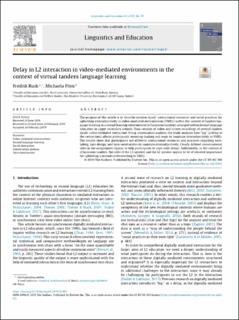| dc.contributor.author | Rusk, Fredrik Karl Henry | |
| dc.contributor.author | Pörn, Michaela | |
| dc.date.accessioned | 2020-06-15T11:47:56Z | |
| dc.date.available | 2020-06-15T11:47:56Z | |
| dc.date.created | 2019-04-09T09:10:54Z | |
| dc.date.issued | 2019 | |
| dc.identifier.citation | Rusk, F., Pörn, M. (2019). Delay in L2 interaction in video-mediated environments in the context of virtual tandem language learning. Linguistics and Education, 50, 56-70. doi: | en_US |
| dc.identifier.issn | 1873-1864 | |
| dc.identifier.uri | https://hdl.handle.net/11250/2658058 | |
| dc.description.abstract | The purpose of this article is to describe tandem dyads’ interactional resources and social practices for upholding intersubjectivity in video-mediated environments (VMEs) within the context of tandem language learning in a virtual learning environment (eClassroom tandem) arranged within formal language education in upper secondary schools. Data consists of video and screen recordings of several tandem dyads’ video-mediated interaction. Using conversation analysis, the study analyses how “lag” (a delay in the connection) affects participants’ meaning-making and ways to maintain intersubjectivity in VMEs. The results show that participants use different interactional resources and practices regarding turn-taking, turn design, and turn construction to maintain intersubjectivity. Clearly defined conversational roles in the assignments appear to help participants to cope with delays. Additionally, in the context of eClassroom tandem, the roles of the L1 speaker and the L2 speaker appear to be of situated importance for upholding a mutual understanding in VMEs. | en_US |
| dc.language.iso | eng | en_US |
| dc.publisher | Elsevier Science | en_US |
| dc.rights | Attribution-NonCommercial-NoDerivatives 4.0 Internasjonal | * |
| dc.rights.uri | http://creativecommons.org/licenses/by-nc-nd/4.0/deed.no | * |
| dc.title | Delay in L2 interaction in video-mediated environments in the context of virtual tandem language learning | en_US |
| dc.type | Peer reviewed | en_US |
| dc.type | Journal article | en_US |
| dc.description.version | publishedVersion | en_US |
| dc.rights.holder | © 2019 The Author(s) | en_US |
| dc.subject.nsi | VDP::Samfunnsvitenskap: 200::Pedagogiske fag: 280::Fagdidaktikk: 283 | en_US |
| dc.subject.nsi | VDP::Humaniora: 000::Språkvitenskapelige fag: 010 | en_US |
| dc.source.pagenumber | 56-70 | en_US |
| dc.source.volume | 50 | en_US |
| dc.source.journal | Linguistics and Education | en_US |
| dc.identifier.doi | 10.1016/j.linged.2019.02.003 | |
| dc.identifier.cristin | 1690985 | |
| dc.description.localcode | Unit Licence Agreement | en_US |

